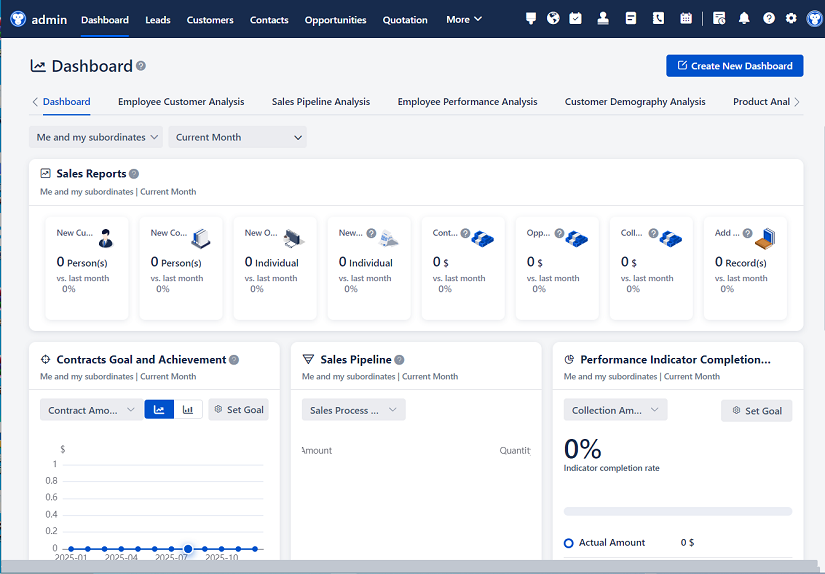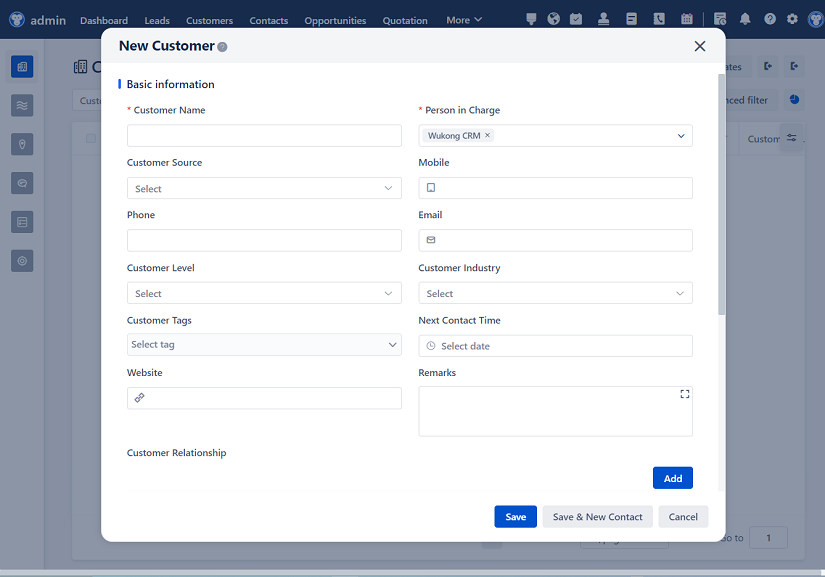
△Click on the top right corner to try Wukong CRM for free
Look, let’s be real for a second — managing customer relationships in a corporate environment isn’t just about being nice or sending the occasional thank-you email. It’s serious business. And if you’re not doing it right, you’re probably losing money, time, and trust without even realizing it. That’s why we’ve got these Corporate CRM Management Regulations and Usage Standards. I know, sounds kind of dry, like something HR would slap on a binder and forget about. But honestly? These rules are actually here to help us — the people who talk to customers, manage accounts, and keep things running smoothly.
So first off, what exactly is a CRM? Well, it stands for Customer Relationship Management, but think of it as your digital memory bank for everything related to clients. Every call, every email, every meeting note — it all lives in there. The system remembers what you might forget, and that’s powerful. But only if we use it properly. That’s where these regulations come in.
Free use of CRM system: Free CRM
One thing I’ve noticed — and I’m guilty of this too — is that people treat the CRM like a personal notebook. They’ll jot down quick notes only they can understand, skip updating records after meetings, or worse, keep important info in their inbox instead of logging it. That’s a problem. Because when someone else needs to step in — maybe you’re on vacation, or the account gets handed over — suddenly no one knows what’s going on. So rule number one: always log interactions promptly. Like, right after the call or meeting. Don’t tell yourself “I’ll do it later.” Later never comes.
And speaking of logging, be specific. Don’t just write “discussed project.” Say what was discussed. What decisions were made? Who’s responsible for next steps? What’s the deadline? The more detail, the better. Think of it like leaving breadcrumbs for your future self or your teammate. You’ll thank yourself later.
Now, here’s something that trips people up — data ownership. Look, the CRM isn’t yours. It belongs to the company. Your login gives you access, but the information in there? That’s company property. So don’t go thinking you can take your contact list with you when you leave. Not cool, not legal, and definitely against policy. Plus, it messes things up for everyone else who relied on that relationship.
Another biggie: accuracy. I’ve seen so many outdated job titles, wrong phone numbers, and inactive email addresses floating around in our system. It makes us look bad. Imagine sending an offer to someone who left the company six months ago. Awkward, right? So part of your job — yes, part of your actual job — is to verify and update client information regularly. If you’re talking to someone and their title changed, update it. If a contact moved to a new company, make a note. Small effort, huge impact.

Permissions matter too. Not everyone should have access to everything. Sales teams need different info than support or finance. So we’ve set up role-based access. That means you only see what you need to do your job. It’s not about mistrust — it’s about security and efficiency. So don’t try to borrow someone else’s login or ask for higher permissions “just in case.” If you genuinely need more access, talk to your manager. There’s a process for that.

And let’s talk about consistency. We’ve standardized how we label opportunities, track stages, and score leads. Why? Because if everyone does it differently, the data becomes useless. Imagine trying to forecast sales when half the team says “proposal sent” means one thing and the other half means something totally different. Chaos. So please, follow the naming conventions and stage definitions we’ve agreed on. It’s not about being rigid — it’s about making sure the numbers we report actually mean something.
Security is another thing we can’t ignore. Our CRM holds sensitive data — names, emails, contract details, sometimes even financial terms. That stuff can’t fall into the wrong hands. So strong passwords are a must. No reusing old ones, no sharing credentials, and definitely no writing passwords on sticky notes. Two-factor authentication? Turn it on. It takes two seconds and could save us from a major breach.
Also, be careful about exporting data. Sure, sometimes you need to pull a report or share a list, but don’t download entire client databases “just in case.” That’s risky. If you need data outside the system, go through the proper channels. Ask IT or compliance. They’ll help you do it safely.
Now, I get it — CRMs can feel clunky sometimes. Maybe the interface isn’t perfect, or it takes a few extra clicks to log something. But complaining about it won’t fix it. What helps is giving feedback. If something’s not working, tell the CRM admin team. Suggest improvements. Maybe there’s a feature you didn’t know about, or maybe your idea leads to an upgrade. We’re supposed to be using the tool, not fighting it.
Training is another key piece. Just because you used a CRM at your last job doesn’t mean you know ours inside out. Features change, processes evolve. So attend the training sessions. Watch the walkthrough videos. Ask questions. It’s not a waste of time — it’s an investment in doing your job better.
And hey, leadership — this applies to you too. If you want your team to use the CRM consistently, you’ve got to model that behavior. When managers skip updates or bypass the system, it sends a message: “This isn’t really important.” But it is important. So lead by example. Check the CRM before meetings. Reference logged notes in conversations. Show your team you value the system.
Integration is another thing worth mentioning. Our CRM doesn’t live in a vacuum. It connects with email, calendar, marketing tools, even billing systems. That’s great — it saves time and reduces manual entry. But it only works if we respect those connections. For example, if your email syncs automatically, don’t delete conversations from the CRM side unless you’re sure they’re irrelevant. You might accidentally erase something important.

Backups and audits — yeah, they sound boring, but they’re crucial. The system runs regular backups, but we also do periodic audits to check data quality. That means someone might review your entries to make sure they’re complete and accurate. Don’t take it personally. It’s not about catching you doing something wrong — it’s about keeping the whole system reliable.

Oh, and one thing people forget: CRM hygiene. Just like cleaning your desk, you’ve got to clean your CRM records. Archive old projects. Remove duplicates. Update statuses. A cluttered CRM is a useless CRM. Set aside 15 minutes a week to tidy up. Your future self will appreciate it.
Let’s also talk about collaboration. The CRM isn’t just for individual use — it’s a team tool. If you’re working on an account with someone else, tag them in notes, assign tasks, use the @mention feature. That way, everyone stays in the loop without endless email chains.
And when it comes to reporting — oh man, this is where good CRM usage pays off. Accurate, up-to-date data means our sales forecasts are realistic, our marketing campaigns are targeted, and our customer service is proactive. Bad data? Leads to bad decisions. So every time you log something correctly, you’re helping the whole company make smarter choices.
Finally, remember that the CRM is meant to serve you, not the other way around. It’s here to reduce busywork, improve communication, and help you build stronger relationships with clients. When used well, it frees you up to focus on what really matters — solving problems, closing deals, and delivering value.
So yeah, these regulations might seem strict, but they’re not about control. They’re about clarity, consistency, and care. Care for our clients, care for our colleagues, and care for the integrity of our business. Follow them, give feedback, and treat the CRM like the valuable tool it is. Because at the end of the day, better CRM habits don’t just make reports look nicer — they help us do our jobs better, together.
FAQs (Frequently Anticipated Questions):
Q: Do I really have to log every single interaction? Even quick calls?
A: Yes, ideally. Even short calls can contain important details — a change in timeline, a concern raised, a new stakeholder mentioned. Logging them keeps the record complete.
Q: What if I forget to update the CRM right away? Can I just backdate it?
A: You can add the note later, but don’t falsify the timestamp. Be honest about when you’re entering it. Better late than never — but aim for timely updates.
Q: Can I use my personal CRM or spreadsheet alongside the company system?
A: You can use personal tools for planning, but all official client data must live in the company CRM. Personal spreadsheets shouldn’t replace the central system.
Q: Who do I contact if I think a contact’s info is wrong but I can’t verify it?
A: Flag it in the system with a note like “Info unconfirmed — needs verification,” and reach out to the client when appropriate. Don’t guess or assume.
Q: Is it okay to delete a duplicate contact record?
A: Not without checking first. Merging records is safer than deleting. Use the merge function if available, or ask your CRM admin for help.
Q: What happens if I accidentally enter wrong information?
A: Fix it as soon as you notice. Add a note explaining the correction if needed. Mistakes happen — what matters is fixing them quickly and transparently.
Q: Can I export client data for a presentation?
A: Only with approval and following data protection rules. Strip out sensitive info if possible, and never share exported files publicly or via unsecured channels.
Q: How often should I review my accounts in the CRM?
A: At least once a week. Check for overdue tasks, upcoming renewals, or stale opportunities. Make it part of your routine.
Q: Are mobile CRM apps secure?
A: Yes, if company-approved and used with secure login practices. Avoid public Wi-Fi when accessing sensitive data, and enable remote wipe features.
Q: What if I disagree with the sales stage definitions?
A: Bring it up in a team meeting or with your manager. We can review and adjust standards if needed — but until then, please use the current framework for consistency.
Related links:
Free trial of CRM
Understand CRM software

△Click on the top right corner to try Wukong CRM for free